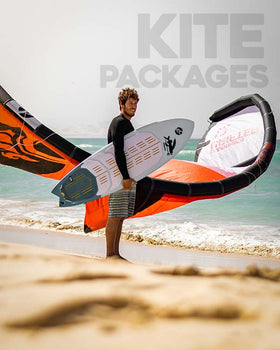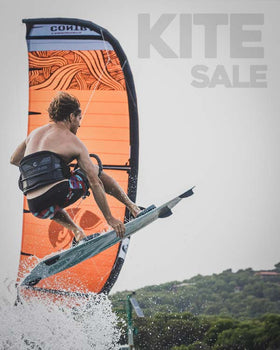
Kiteboarding Control Bars
The Control bar is an essential part of your kiteboarding kit, it is literally where the rubber hits the road between you, your board, and the kite. The Control System is your kite liaison. There are a plethora of different setups to consider and a host of personal preferences. Among the things to consider are the size, whether the bar is adjustable, is the depower adjustment above or below the bar, is the main power line coated or not coated, does the bar stay within reach when you let go of the bar, and does the bar automatically unwind the center lines. Let's take a look at some different bars and dissect the different advantages and disadvantages.
Control bar size
The size of the Control Bar has a direct influence on how quickly the kite turns. Larger kites are generally paired with longer bars since big kites turn slower than small kites although if you like a slow turning kite you can use a shorter than recommended bar to make your kite slower turning. The same goes for small kites, if you want the kite to turn faster, you can use a longer than recommended bar to achieve a faster turning setup. In general you will find the recommended size to be best as a short bar on a big kite will feel too slow in most cases and a long bar with a small kite will feel squirrely.

Adjustable Control Bars
One great way to get more out of your Control System is to get an adjustable bar. These bars have adjustable lengths that allow you to use the same bar with multiple sized kites. With a simple adjustment the bar can be made longer or shorter depending on what sized kite you are flying. This can save you both time and money as you don't need multiple bars and you don't need to run back to your car for a different bar when you switch kites. The Cabrinha Overdrive, the Duotone Trust Bar, the Liquid Force Mission Control, and the Naish Torque all have the ability to adjust the bar in this way.

Above the bar or below the bar depower

Whether the depower adjustment is located above or below the bar is a matter of your personal preference. Below the bar systems have the advantage keeping the above the bar area uncluttered while the above the bar systems have the advantage of keeping the below the bar area uncluttered. Some riders find the below the bar systems to be hard to adjust when overpowered. Others find the dangle of the depowered above the bar systems to be distracting. If you ride wakestyle, you'll probably prefer an above the bar system that has a cleaner chicken loop for unhooking and hooking back in. Some Brands do it one way while others have both configurations. For instance Cabrinha and Liquid Force only do it above the bar while Naish has both options. Yet another option gives you the best of both worlds with its Click bar that has the depower neither above nor below but rather integrated into the bar itself. While this is superior to the other options, it will cost you a bit more and as of this post the Click Bar does not have length adjustability.

Coated or uncoated main power line

Whether the main power line is coated or uncoated is another personal preference to consider. Cabrinha, Duotone, and Liquid Force bars all have a sheathed center line while Naish's and Slingshot's center lines are not coated. Sheathed center lines have the advantage of not binding on the center bar hole when steering the kite. The solution is simply a matter of technique though. If you try to turn the kite and then pull it, the coated center line will not travel freely, but if you pull the bar in first you won't have this problem. Uncoated main lines allow you to pull the bar in without binding regardless of whether you angle the bar first, second, or simultaneously. The major advantage of a coated center line is that the PU coating protects the mainline from wearing down whereas an uncoated mainline will wear down over time requiring you to replace it from time to time. It's a pretty easy maintenance job though.

Bars that stay within reach and bars that don't

Yet another matter of personal preference, bars that stay within you reach even when you let go and bars that don't is another factor that may or may not be important for you. Generally beginners like the bar to stay in reach. Cabrinha has the recoils system that uses a spring to keep the bar close where the spring compresses so you still have additional depower. Duotone, Slingshot, and Naish have a slidable stopper that keeps the bar close when you want it close but also let you push the stopper away when you want more depower. Liquid Force has no stopper. Kitesurfers and foilers tend to want more throw (ability to push the bar further away) because they want to be able to depower the bar as much as possible. Regardless, if the bar is out of your reach, the solution is simply to grab the main line and pull it in with one hand while you grab the bar with the other. The more you ride the less this will matter to you.

Bars that automatically unwind the center lines
All Cabrinha bars, the Duotone Trust bar, and all Liquid Force bar do not automatically unwind but do allow for below the bar manual unwinding. Slingshot has a pivot point at the center line V point that essentially keeps the center lines from getting twisted and then there's the Duotone Click bar that has a square PU covered main line with a square bar center hole and a pivot point below the bar that keeps the center lines from twisting.



Leave a comment